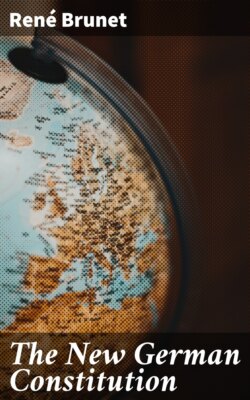Читать книгу The New German Constitution - René Brunet - Страница 19
На сайте Литреса книга снята с продажи.
3.—THE CREATION OF A STATE—THURINGIA.
ОглавлениеThe provisions which we have elucidated have already been put into operation. A new state has appeared in the Reich created by the fusion of several former states.
Almost immediately after the revolution of November, 1918, a project was born in central Germany to fuse several states there and to form of their territories the state of “Thuringia.”
First the two states of Reuss reunited. On December 21, 1918, they organized an administration in common and the fusion became operative on April 4, 1919. This new state appeared thereafter as a sort of centre for crystallization. The first state to join this movement was the Republic of Altenburg, with which Reuss had many interests in common.
But this development toward the federation of states of central Germany was soon interrupted and seemed for a time even definitely arrested. The men who were pushing the project of extending this movement conceived the idea of the creation of a “Great Thuringia,” which would comprise important parts of Prussian territory and which would have as the economic and political centre and as capital the Prussian city of Erfurt.
The execution of this plan aroused violent opposition on the part of the government of Prussia, such as it manifested whenever the question came up of the separation from it of any part of its territory. It encountered also the strong objection on the part of the authorities and the population of Erfurt who preferred the present advantage of belonging to the most powerful German state rather than the possible benefit of becoming an important element in a new state. The project of a “Great Thuringia” was abandoned and the effort continued as before to form a state which should comprise all the states of Thuringia without appropriating any Prussian territory.
Of the eight republics of central Germany included in this plan of fusion one, that of Coburg,[12] refused to join the movement. This republic, having on October 30 inaugurated a plebiscite to find out whether the population wished to belong to Bavaria or to the future “Thuringia,” obtained 3,460 votes for Thuringia and 16,102 votes for Bavaria. This reunion with Bavaria was then consummated, with the consent of Bavaria, by a law of the Reich of April 30, 1920.
As for seven other republics—Saxe-Weimar-Eisenach, Saxe-Altenburg, Reuss, Saxe-Gotha, Schwarzburg-Rudolstadt, Schwarzburg-Sondershausen and Saxe-Meiningen—they concluded a “treaty” by which they combined in a “community” to prepare their complete fusion.
To this effect the treaty provided two organs:
(a) A popular Council, the legislative organ of the “Community,” composed of representatives of each of the seven Diets;
(b) A Council of States, the executive organ, consisting of representatives of each of the seven governments.
These organs had as their mission to study and take all preliminary measures necessary for the fusion. To permit the accomplishment of this mission the states transferred to them all their legislative and administrative powers necessary. The laws voted by the popular Council were therefore compulsory in the territory of all the seven states. They were particularly operative over the governments and the administrative authorities of these states.[13]
The common organs were in addition instructed to prepare the Constitution of their future state.
When all these necessary preliminary provisions had been taken the Reich declared the fusion in being. All the interested states being in agreement with this step an ordinary law sufficed; and it carries the date of April 30, 1920.
